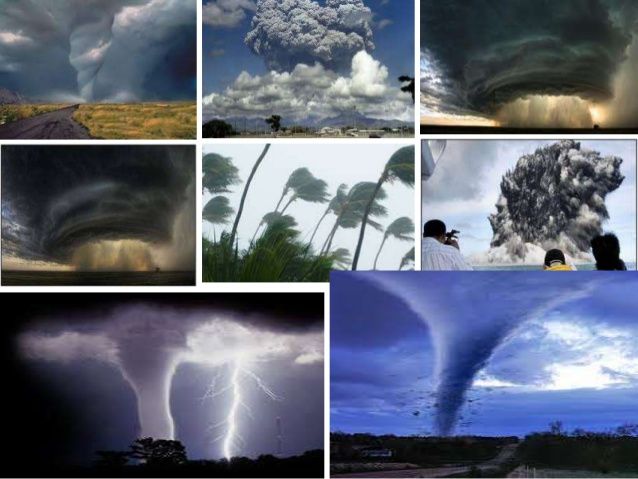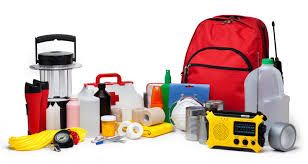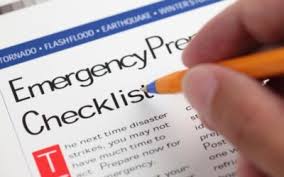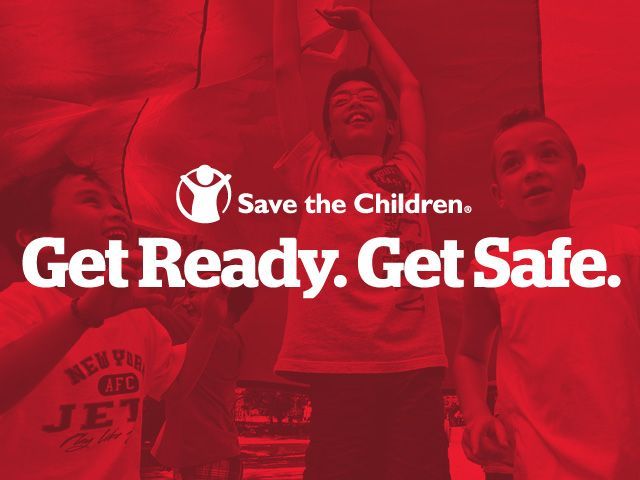HOW TO PREPARE FOR AND HANDLE AN EMERGENCY
Disasters, whether they be large or small, can be frightening, confusing and potentially deadly. Being prepared with supplies and emergency plans can help get us through these situations as safely as possible.
In the event of a major disaster, studies have shown that it may be up to 72-hours before services, help and shelters become available.
Depending on where you live, there are many possible emergency situations:
- Blizzard
 Wildfire
Wildfire- Hailstorm
- Mud slide
- Earthquake
- Volcano
- Tsunami
- Flood
- Tornado
- Hurricane
- Drought
- Power failure
- Terrorism
- Ice storms
Both the American Red Cross and FEMA (Federal Emergency Management Agency) recommend you have basic supplies for that 72-hour period.
What is a 72-hour kit?
- A 72-hour kit contains food, clothing, and basic supplies that would sustain 1 person for 3 days (72-hours) during an emergency.
Three types of 72-hour kits
- The Standard 72-hour kit contains food, clothing, and basic supplies.
- A 72-hour First Aid kit contains medicines, bandages, and other equipment that would be useful in the crises most likely to happen in your area.
- Children’s Activities kits contain games, toys, books and other items to help children wait out a crisis.
Contents of Standard 72-hour kit
- Ready-to-eat canned meats, fruits and vegetables (And a can opener)
- Canned juices, milk and soup
- High energy foods such as hard candy, sweetened cereal, candy bars and cookies
- Food for infants and those on special diets
- Energy bars
- Snack-sized canned goods (applesauce, chili)
- Items kids like --goldfish crackers, fruit roll-ups, etc.
- 2 quarts of water per day for each person
- Tuna and mayonnaise
- Uncooked instant cereals
- Granola bars
- Instant coffee, tea for the adults
- Extra clothing, at least two complete changes
- Coats, sweater, mittens or gloves in winter
- Sunglasses and sun block in summer
- Diapers and wipes
What to avoid:
- Unfamiliar foods.
- Children need foods they know and like.
- Foods children with allergies cannot eat.
- High fat foods.
- Salty foods.
- Dehydrated foods that require a lot of water.
Contents of 72-hour First Aid Kit
 First aid handbook
First aid handbook- Flashlight with extra batteries
- Radio with extra batteries
- Shovel and useful tools
- Household bleach to treat drinking water
- Fire extinguisher
- Aromatic spirits of ammonia -- one unbroken tube
- Acetaminophen
- Calamine lotion
- Thermometer (one oral and one rectal)
- Scissors and Tweezers
- Safety pins (assorted sizes)
- Adhesive tape
- Large box of assorted adhesive bandages
- Waterproof Matches (for sterilizing)
- Absorbent cotton
- Rubbing alcohol
- Antibiotic ointment (Neosporin or Bacitracin)
- Bicarbonate of soda (for shock and upset stomach) Diarrhea medicine (Kaopectate or Pepto-Bismol)
- Elastic bandages (for sprains and aches) -- one 3 inch and one 6 inch
- Gauze - one roll
- Hot water bottle
- Hydrogen peroxide (plastic bottle)
- Ipecac syrup (induces vomiting)
- Finger splints
- Roller bandages two 1 inch and two 2 inch
- 3-by-3 sterile pads
- Knife
- Triangle bandages
- Hand soap
- Water purification pills and/or bottle of 2% tincture of iodine
- Eye drops
- Medicine dropper
- Razor blades
- Needles
- Throat lozenges
Contents of 72-hour Activity Kit
- Favorite books
- Crayons, pencils or marking paper and plenty of paper
- Scissors and glue
- 2 favorite toys -- like a doll or action figure
- Travel games
- Small stuffed animal
- A deck of cards
- A puzzle with many pieces
- Special blanket or pillow
- Pictures of the family and pet (in a zip-lock bag)
Be sure to have a plan for each type of emergency you may encounter:
 Have a predetermined evacuation place, but do as instructed by authorities.
Have a predetermined evacuation place, but do as instructed by authorities.- Make sure parents know how to find their children if evacuated.
- Cell phone number
- Pager number
- Have an out-of-state contact person (you will provide information to) for parents to call when local lines are down.
- Stay informed. Commercial radio, TV stations, even social media will provide as much information as possible.
For more information on how to plan for and handle various emergency situations, try our online classes:
